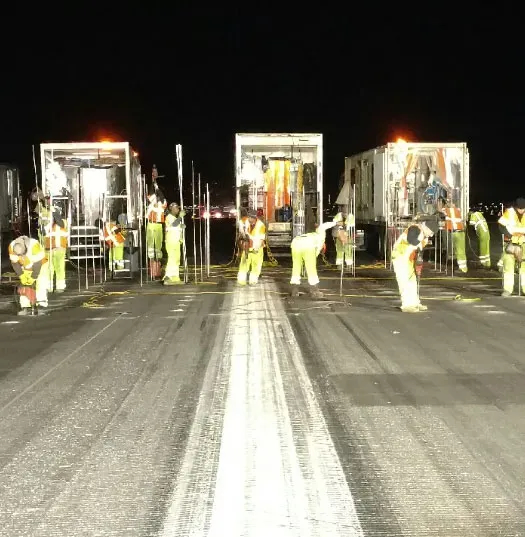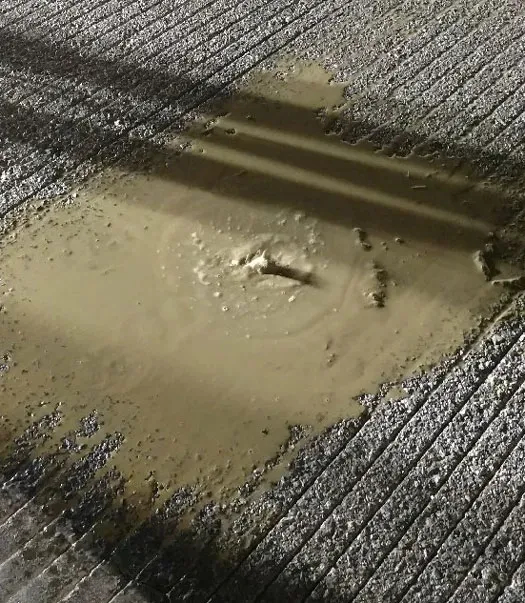San Francisco International Airport Avoids Runway Reconstruction
Problem
The high volume of aircraft departing and landing at San Francisco International Airport caused portions of the 10R-28L asphalt runway to prematurely reach the end of their functional life. The results of a remaining life pavement analysis (FAARFIELD) indicated that action was necessary to restore the pavement to an acceptable remaining lifespan. URETEK was hired to resolve this pavement preservation problem.
Analysis
URETEK used the results from the FAARFIELD analysis and accompanying geotechnical field testing to develop a repair solution. A traditional, full-depth repair was impractical because it would have required shutting down the runway for an extended length of time. The URETEK Deep Injection® (UDI) process promised the San Francisco Airport engineers a faster and more cost-effective alternative. To determine where to target UDI treatment, URETEK used Dynamic Cone Penetrometer (DCP) tests to identify void areas between the cement treated base (CTB) and the subbase. The DCP tests revealed a very weak saturated layer of soils approximately eight feet below the surface.
Solution
UDI was performed uniformly at a depth of ten feet and wherever else DCP testing detected voids in the soil. The injections of polyurethane material were designed to stabilize the subgrade below the pavement and fill voids between the CTB and subbase layers. URETEK finalized the job by milling and overlaying to remove weakened asphalt and create a smooth pavement surface.
Result
URETEK hired Dynatest Consulting to perform Heavy Weight Deflectometer (HWD) testing and to determine resilient modulus (material stiffness) values for pre-treatment and post-treatment conditions. The subgrade modulus and CTB modulus in the areas injected with polymer improved by an average of 15.7% and 21.1%, respectively, despite record rainfall in the area between the time of pre- and post-injection testing. These remarkable results were supplemented with a post-injection DCP test, and the single digit blow counts improved tremendously from pre-injection levels. The FAARFIELD analysis was performed again following URETEK’s repairs and indicated a remaining life of greater than 20 years for all injected areas of pavement. For a fraction of the time and cost of a traditional, full reconstruction project, URETEK gave new life to a heavily used runway at the San Francisco International Airport.
URETEK Deep Injection® (UDI)
Widely referenced throughout our industry, UDI involves the injection of structural polymer into base and subgrade soils to increase the load bearing capacity. This is achieved by injecting the polymer through small holes drilled directly through the pavement structure to depths determined by site-specific analysis. Our URETEK 486 Star® material flows easily into voids and weak zones within the soil mass below. Through a controlled chemical reaction, the expanding polymer compacts surrounding soils and applies a controlled pressure on targeted areas of the affected pavement above. If needed, a multi-injection design plan is utilized to gently return the pavement to its original grade. The composite material quickly cures into a strong, dimensionally stable, and water-resistant geo-material, providing years of reliable service.
URETEK 486 Star®
URETEK 486 Star® polymer is a two-component, high-density, expanding thermoset polyurethane system. It was developed to be the ideal solution for under-sealing, void filling, lifting of settled pavement, stabilization and stiffening of weak soils, and for encapsulating and sealing buried infrastructure. URETEK 486 Star® is environmentally inert, non-toxic, and resists underground water erosion or weakening due to its industry-leading hydrophobic properties.


